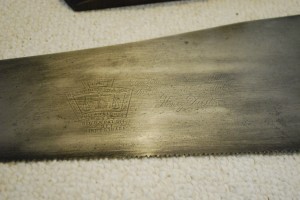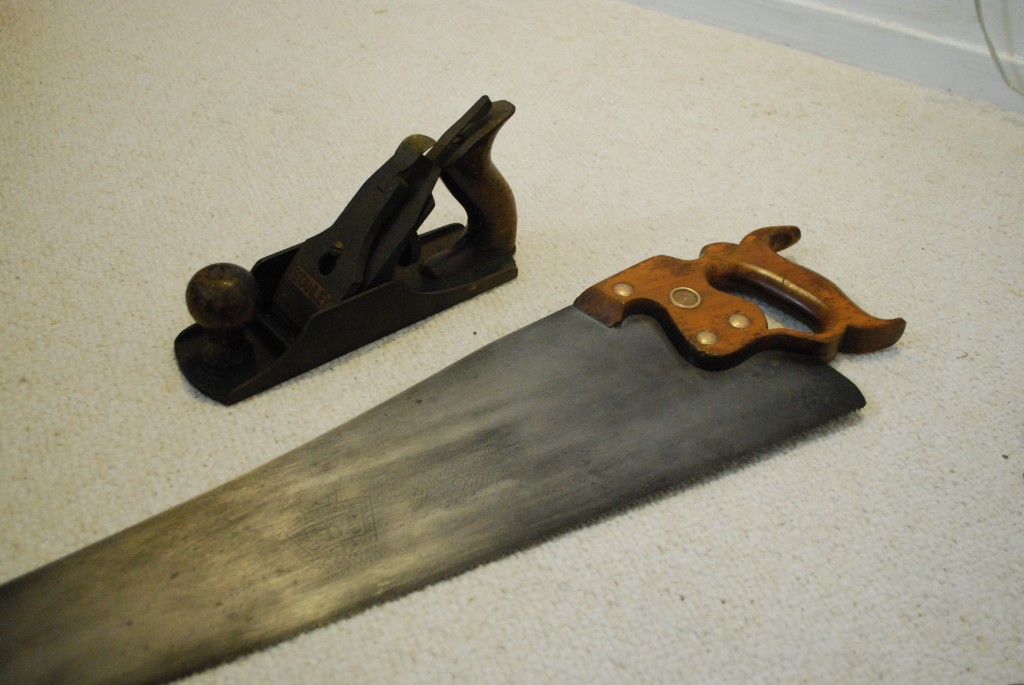This was a great garage sale find. The guy’s father had about 12 hand saws of various sorts, I bought 7 of them including a mishandled tenon saw and a latter model mitre-box saw.
It’s a good ol’ D8 24″ crosscut 8 TPI. The medallion dates it from 1898-1917 and the etch indicates the later of that period probably 1910-1917. I like hundred-year-old antiques that still work.
I didn’t take any process pictures, though I wish I had one of the handle before I finished it. I’d like to compare the look of the handle to decide whether I’m happy with the finish, oh well.
As found the blade was typically oxidized (charcoal-brown scale) but not especially rusted. Handle was rashed with a little wear here-and-there but a nice size a a good fit to my hand. Had no idea whether the etch was still hiding under all the crud.
I cleaned the blade with my proprietary process (which may or may not include a battery charger…). Indeed it had an etch and I had a mid-model D8 on my hands, something I suspected but couldn’t know for sure until the steel came clean (shameless pun).
I jointed a sharpened up the saw. It had a fair amount of breasting which I knocked down a little. I matched the rake (~12°) which I feel is too aggressive for anything other than wet boards. I’ll re-joint it to even the teeth again and give it more like 18° rake. I had to nudge just a little more set after the sharpening because it was binding.
The handle was a bit of a mess. Like many user saws as old as mine the shellac (or whatever finish Disston was using) had worn off all the ergonomic areas. Also, like all planes and saws found in garages, someone had used the saw to hold down paint tarps for many years. So I stripped it. I used the orange stripper and have no complaints about it’s performance. I recommend the medium-brown Scotch-Brite pads for removing the finish. These pads also have a moderate sanding ability, which can be a trade-off. Normally a scraper would be preferable but as most of the surface of a saw-handle isn’t flat.
To get the warmth back I used a light stain and waxed it. I’m still not sure if I like the final tone of the finish, I can say that the handle rather perfectly matches the D8 ripsaw handle found alongside the crosscut. That ripsaw may be my next project (perhaps with process photos). Some of the wood’s patina was left after the stripping and sanding, and once stained is very pleasing.
The saw-nuts were nearly black with oxidation so I cleaned them up. Not having any Brasso on hand (why don’t I?) I used some Barkeep’s Friend and made a paste. Some time and many little circles with an old toothbrush later, I’m happy with the results. Just make sure to wipe/rinse off the paste afterwards.
A tip when re-installing the nuts is to lightly tap the smooth (medallion) side with a scrap of wood and a mallet. This seats the head of the bolt in the countersink and keeps it from spinning. Everything was liberally waxed in several coats. I like Johnson’s wax, despite the odor while applying it.
While this wasn’t my first trip around the block of cleaning a saw, it was the first time I refinished it to this extent. Fairly happy with the results. If I were redoing this saw for my aesthetics rather than accuracy, I would stain the handle much darker to a rosewood hue.

No Comments